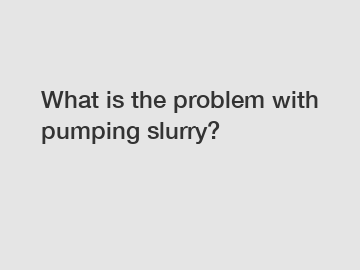What is the problem with pumping slurry?
Welcome back, fellow readers, as we dive deep into an intriguing yet often overlooked aspect of industrial processes - the pumping of slurry. You may have heard about this complex process, but what exactly is the problem with pumping slurry? In this blog, we will unravel the challenges faced by industry professionals when handling slurry. So, grab your hard hats and join us on this enlightening journey!
A Slurry Primer.
Before we delve into the difficulties of slurry pumping, let's briefly understand what slurry actually is. Slurry is a mixture of liquid and solid particles, akin to a thick and viscous shampoo. It is commonly created in mining, wastewater treatment, oil refineries, and various other industries. The nature of slurry varies widely, depending on the application, composition, and particle size being transported.

The Challenge of Particle Size Distribution.
One of the major problems associated with pumping slurry arises from the wide-ranging particle size distribution. A slurry can contain particles as small as a grain of sand and as large as boulders. The presence of different particle sizes results in uneven flow and increased wear on the pump components. Achieving efficient pumping while handling different particle sizes demands a carefully planned system design and an understanding of the slurry's characteristics.
Abrasive Nature of Slurry.
Another difficulty lies in the abrasive nature of slurry. The solid particles present in the slurry can be abrasive and cause considerable damage to pump components. Traditional pumps are often ill-equipped to handle this abrasive wear, resulting in frequent breakdowns and costly downtime. Engineers and inventors are continuously exploring new materials and pump designs that can withstand the harsh conditions and prolonged exposure to abrasive slurry.
Handling High Solids Concentrations.
Slurries with high solids concentrations present their own set of problems. The viscosity of such mixtures increases significantly, making it harder to maintain smooth flow and control pump efficiency. Apart from increased energy consumption, this also leads to higher maintenance requirements and increased downtime for cleaning and repairs. Developing pump systems that can handle varying solids concentrations without sacrificing performance is a constant challenge for engineers.
Viscosity and Rheology.
Slurry's high viscosity and complex rheological properties pose further obstacles in successful pumping operations. As rheology determines flow behavior, it becomes crucial to comprehend the interplay between particle interactions, concentration, and the carrier liquid. The non-Newtonian nature of slurry means that its viscosity is not constant, varying with shear rates. As a result, matching the pump's characteristics with the slurry's rheology becomes crucial for optimal operation.
Clogging and System Blockages.
Slurry can be a notorious clogger! The risk of clogging and system blockages increases when a slurry contains fine particles or unconventional additives. These blockages reduce pump efficiency and can lead to overflowing, affecting the overall operation of the system. Engineers must tackle this challenge by employing innovative technologies, such as specialized impeller designs and modified flow patterns, to prevent and mitigate system blockages.
Pump Selection and Customization.
Selecting the appropriate pump for slurry pumping is easier said than done. Factors such as particle size distribution, density, viscosity, solids concentration, and flow rates all need careful scrutiny to ensure efficient and reliable operation. Pump customization is often required to meet specific application demands. The interplay between these factors requires a multidisciplinary approach, incorporating fluid dynamics, materials science, and mechanical engineering expertise.
Innovation and the Future of Slurry Pumping.
Despite the challenges, industry professionals continue to develop novel techniques and technologies to enhance slurry pumping efficiency. Research into advanced materials, pump designs, and intelligent control systems are opening doors to greater reliability, reduced maintenance, and increased productivity. Collaboration between researchers, manufacturers, and end-users fosters continuous improvement and ensures future advancements in slurry pumping.
Conclusion.
As we reach the end of this enlightening journey, we hope you have gained a deeper understanding of the challenges faced by professionals in the field of slurry pumping. The complex nature of slurry, including variations in particle size distribution, abrasiveness, solids concentration, viscosity, and rheology, demands constant innovation and tailored solutions. Through collaboration and advancement, we can overcome these challenges and ensure efficient and reliable slurry pumping for various industries, thereby facilitating their growth and development.
For more Foam Slurry Pump, Single-Stage Gravel Pump Suppliers, M/L Slurry Pumpinformation, please contact us. We will provide professional answers.

Comments
0